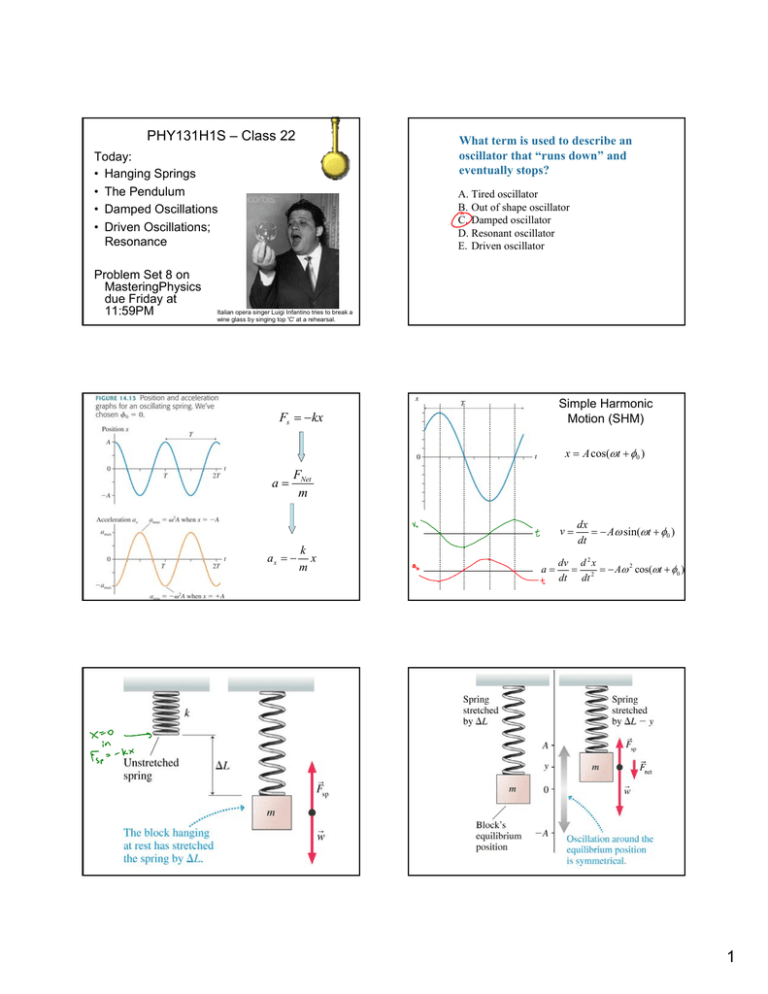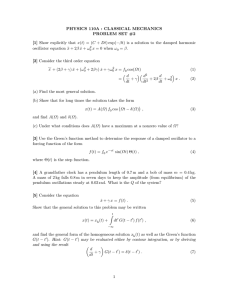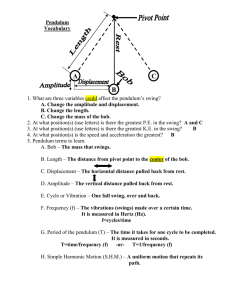Slides
advertisement

PHY131H1S – Class 22 What term is used to describe an oscillator that “runs down” and eventually stops? Today: • Hanging Springs • The Pendulum • Damped Oscillations • Driven Oscillations; Resonance Problem Set 8 on MasteringPhysics due Friday at 11:59PM A. Tired oscillator B. Out of shape oscillator C. Damped oscillator D. Resonant oscillator E. Driven oscillator Italian opera singer Luigi Infantino tries to break a wine glass by singing top 'C' at a rehearsal. Simple Harmonic Motion (SHM) Fs = − kx x = A cos(ωt + φ0 ) a= FNet m v= ax = − k x m a= dx = − Aω sin(ωt + φ0 ) dt dv d 2 x = = − Aω 2 cos(ωt + φ0 ) dt dt 2 1 End of chapter problem P14.17 • A spring is hung from the ceiling. When a block is attached to its end, it stretches 2.0 cm before reaching its new equilibrium length. The block is then pulled down slightly and released. What is the frequency of oscillation? The Pendulum Suppose we restrict the pendulum’s oscillations to small angles (< 10°). Then we may use the small angle approximation sin θ ≈ θ, where θ is measured in radians. Since θ = s/L, the net force on the mass is Two pendula have the same length, but different mass. The force of gravity, F=mg, is larger for the larger mass. Which will have the longer period? A. the larger mass B. the smaller mass C. neither and the angular frequency of the motion is found to be Mass on Spring versus Pendulum Mass on a Spring Condition for Small S.H.M. oscillations k Angular ω= frequency m Period m T = 2π k Pendulum Small angles ω= T = 2π g L L g A person swings on a swing. When the person sits still, the swing oscillates back and forth at its natural frequency. If, instead, two people sit on the swing, the natural frequency of the swing is A. greater B. the same C. smaller 2 A person swings on a swing. When the person sits still, the swing oscillates back and forth at its natural frequency. If, instead, the person stands on the swing, the natural frequency of the swing is A. greater B. the same C. smaller Damped Oscillations When a mass on a spring experiences the force of the spring as given by Hooke’s Law, as well as a drag force of magnitude |D|=bv, the solution is Driven Oscillations and Resonance • Consider an oscillating system that, when left to itself, oscillates at a frequency f0. We call this the natural frequency of the oscillator. • Suppose that this system is subjected to a periodic external force of frequency fext. This frequency is called the driving frequency. • The amplitude of oscillations is generally not very high if fext differs much from f0. • As fext gets closer and closer to f0, the amplitude of the oscillation rises dramatically. 14.8 Externally Driven Oscillations Resonance! 3



